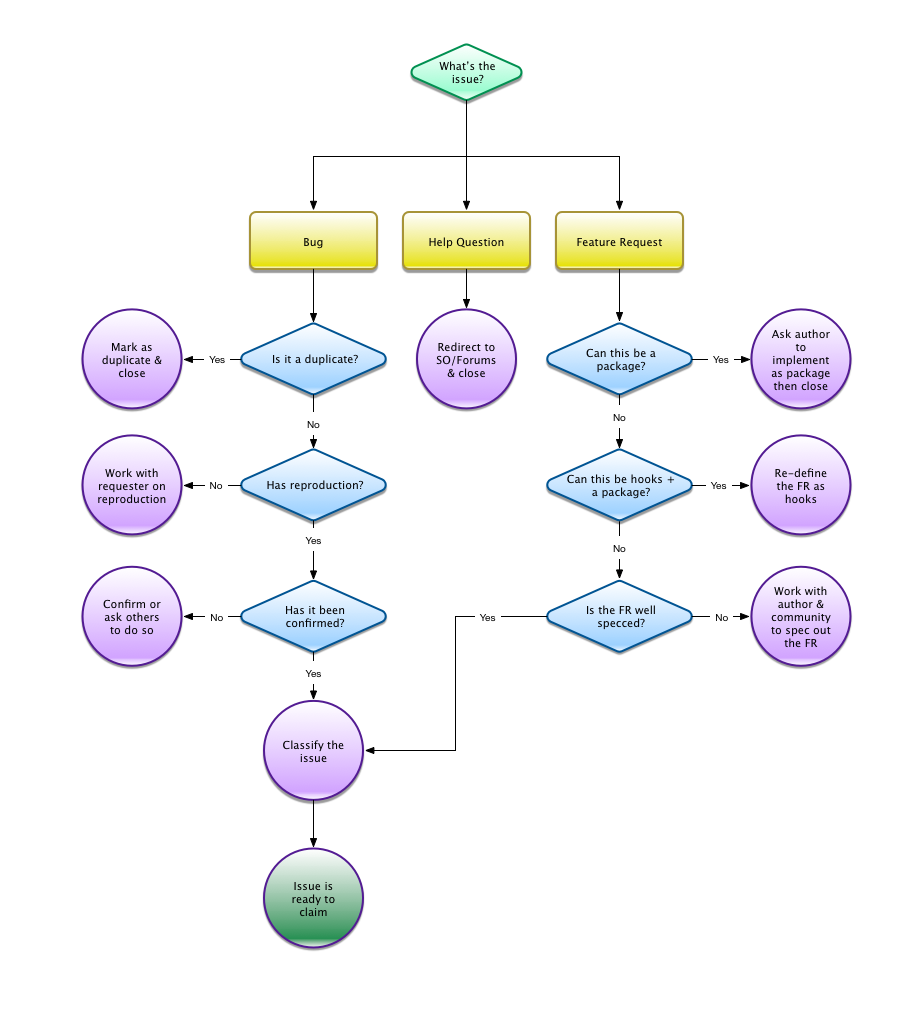This document describes the process Meteor contributors use to organize issues. We use Github issues in this repository to track bugs, and meteor/meteor-feature-requests to track feature requests. Our goal is to maintain a list of issues that are relevant and well-defined (and labeled) such that a contributor can immediately begin working on the code for a fix or feature request. Contributors who want to dive in and write code aren't likely to prioritize working on issues that are ambiguous and have low impact.
We would love to have more contributors who are willing to help out with triaging issues. You can begin by helping issue requesters create good reproductions and by confirming those reproductions on your own machine. It won't be long before the core maintainers notice your work and ask whether you'd like to be promoted to an issue maintainer.
All issues follow the flow outlined below. Your job as an issue maintainer is to work with the requester and others within the community towards the goal of having an issue either become 'claimable' or closed. Read on for more details on the process.
The first step is in determining whether the issue is a bug, help question or feature request. Read on for more details.
We have Stale bot watching this repository with these settings and closing stale issues (40 days without activities). Issues marked as Stage:Confirmed or Stage:Ready are never considered stale.
- Duplicates should be closed and marked as such.
- Add the
buglabel andProject:*labels that apply (a best guess on theProject:is fine; sometimes it's hard to tell exactly which project the issue falls under). - Bugs should have a high-quality reproduction as described here. You may need to help the reporter reduce their bug to a minimal reproduction. Leave the issue open.
- A reproduction should be confirmed by at least one person other than the original reporter. Run the reproduction and validate that the bug exists; then make a note of your findings on the issue. If a reproduction is supplied but doesn't work, make a comment describing what happened.
- Finally, once you've confirmed the reproduction add the
Stage:Confirmedlabel and classify the issue.
Our forums or Community Slack are the place to ask for help on using the framework. Close issues that are help requests and politely refer the author to the above locations.
- For reasons described here, we would prefer features to be built as separate packages. If the feature can clearly be built as a package, explain this to the requester and close the issue.
- If the feature could be built as a package and serves a particular need, encourage the user to contribute it themselves.
- If the underlying issue could be better solved by existing technology, encourage them to seek help in the forums.
- If you haven't closed the issue, add
Project:*labels that apply (a best guess on theProject:is fine, sometimes it's hard to tell exactly which project the issue falls under). - If it's not possible to build the feature as a package (as you identified in step 1), explore whether creating hooks in core would make it possible to do so. If it would, redefine the issue as a request to create those hooks.
- Work with the requester and others in the community to build a clear specification for the feature and update the issue description accordingly.
- Finally, add the
Stage:Confirmedlabel and classify the issue.
Core contributors may add the pull-requests-encouraged label to feature requests. This indicates the feature is aligned with the project roadmap and a high-quality pull request will almost certainly be merged.
Assign a classification (via GH labels) that enables the community to determine how to prioritize which issues to work on. The classification is based on Severity x Impact .
[Severity:has-workaround, Severity:production, Severity:blocks-development]
- If there is a workaround, apply the
Severity:has-workaroundlabel. - If the issue affects production apps, apply the
Severity:productionlabel. - If the issue blocks development (e.g
meteor runis broken), apply theSeverity:blocks-developmentlabel.
[Impact:few, Impact:some, Impact:most]
This is a somewhat subjective label and is interpreted in conjunction with Github's upvotes. As a general guideline:
Impact:fewissues would go unnoticed by almost all users, apart from those using a very niche feature, or a feature in an unusual way.Impact:someissues would impact users using a feature that is commonly but not universally used.Impact:mostissues would impact more or less every user of the framework.
- If the desired fixed or solution is already clear add the label
Stage:Ready. - If discussions are still necessary add the label
Stage:In discussionand start the discussion.
This state indicates that bugs/feature requests have reached the level of quality required for a contributor to begin writing code against (you can easily filter for Ready)
Although this should have already been done by this stage, ensure the issue is correctly labeled and the title/description have been updated to reflect an accurate summary of the issue.
Contributors should comment on and/or assign themselves an issue if they begin working on it so that others know work is in progress.
